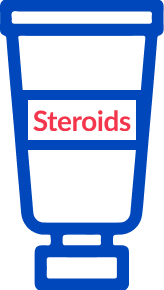How severe is your Atopic Dermatitis?
What is mild Atopic Dermatitis (AD)?
Patients with mild AD may experience areas of dry skin with infrequent itching and/or redness, and have a small to moderate impact on everyday activities, sleep and psychosocial well-being. [1][2]
Who does it affect?
Atopic dermatitis is most common in infants. It may start as early as age 2 to 6 months. Many people outgrow it by early adulthood.[3] The risk increases with certain factors such as a family history of atopy, filaggrin mutations, urban environment or allergic multimorbidity.[4]
Treatment options
Mild AD can typically be managed with topical ointments/creams prescribed by doctors, moisturising the skin, and taking regular care of one's skin health.[3] If you experience multiple AD symptoms more frequently, your AD may have become moderate or severe based on the Dermatology Life Quality Index.[1]


Topical corticosteroids
Side effects may include[11]:
- Atrophy
- Acne
- Perioral dermatitis
- Striae, rosacea and purpura

Topical calcineurin
inhibitors (TCI) (Non-steroidal)
Side effects may include[12][13]:
- Stinging and skin burning
- Pruritus

Topical PDE4 inhibitors (Non-steroidal)
Side effects may include[14]:
- Application site reactions (pain, burning, pruritus, stinging, and erythema)
- Infection (including Kaposi varicelliform eruption, yeast infection, and nasopharyngitis)
- Exacerbation of AD
All images are for representation purpose only
References:
1. Finlay, A. Y. and Khan, G. K. 1994. Dermatology Life Quality Index (DLQI)--a simple practical measure for routine clinical use. Clinical and Experimental Dermatology 19 (3), pp.210-216.(10.1111/j.1365-2230.1994.tb01167.x)
2. Medthority. Atopic Dermatitis Overview [Internet]. Tunbridge Wells, UK; 2021 [updated 2021 July 27, cited 2022 September 19]. Available from: https://www.medthority.com/atopic-dermatitis/atopic-dermatitis-overview/
3. Icahn School of Medicine at Mount Sinai. Atopic Dermatitis. [Internet]. New York City, New York, USA, Mount Sinai; 2022 [updated 2022 November 18, retrieved 2023 May 9]. Available from: https://www.mountsinai.org/health-library/diseases-conditions/atopic-dermatitis
4. A.D. Irvine, P. Mina-Osorio. Disease trajectories in childhood atopic dermatitis: an update and practitioner's guide. Hoboken, New Jersey, USA, Wiley Online Library; 2019 [updated 2019 February 13, accessed 2023 May 9]. Available from: https://onlinelibrary.wiley.com/doi/full/10.1111/bjd.17766
5. Wollenberg A, Barbarot S, Beiber T, et al. Consensus-based European guidelines for treatment of atopic eczema (atopic dermatitis) in adults and children: part I. J Eur Acad Dermatol Venereol. 2018;32(5):657-682.
6. Eichenfield L, Wynnis TL, Berger TG, et al. Guidelines of care for the management of atopic dermatitis: section 2: management and treatment of atopic dermatitis with topical therapies. J Am Acad Dermatol. 2014;71(1):116–132.
7. Joanne R Chalmers, Emma Axon et al. Different strategies for using topical corticosteroids in people with eczema [Internet]. [Place Unknown], National Library of Medicine; 2019 [updated 2022 Mar 11, retrieved 2023 Feb 21]. Available from: https://www.ncbi.nlm.nih.gov/pmc/articles/PMC6582261/
8. Boguniewicz M, Fonacier L, Guttman-Yassky E, Ong PY, Silverberg J, Farrar JR. Atopic dermatitis yardstick: practical recommendations for an evolving therapeutic landscape. Ann Allergy Asthma Immunol. 2018;120(1):10-22
9. Li AW, Yin ES, Antaya RJ. Topical corticosteroid phobia in atopic dermatitis: a systematic review. JAMA Dermatol. 2017;153(10):1036-1042.
10. Beattie PR, Lewis-Jones MS. Parental knowledge of topical therapies in the treatment of childhood atopic dermatitis. Clin Exp Dermatol. 2003;28(5):549-553.
11. Arijit Coondoo, Meghana Phiske, Shyam Verma, Koushik Lahiri. Side-effects of topical steroids: A long overdue revisit. [Place Unknown], National Library of Medicine; 2014 [retrieved 9 May 2023]. Available from: https://www.ncbi.nlm.nih.gov/pmc/articles/PMC4228634/
12. Warner W. Carr. Topical Calcineurin Inhibitors for Atopic Dermatitis: Review and Treatment Recommendations. Pediatr Drugs (2013) 15:303–310
13. Lawrence F. Eichenfield, MDa [Co-chair], Wynnis L. Tom, MD, et al. GUIDELINES OF CARE FOR THE MANAGEMENT OF ATOPIC DERMATITIS: Part 2: Management and Treatment of Atopic Dermatitis with Topical Therapies. J Am Acad Dermatol. 2014 July ; 71(1): 116–132. doi:10.1016/j.jaad.2014.03.023
14. Huan Yang, MD; Ji Wang, MD; Xin Zhang, MD, PhD; et al. Application of Topical Phosphodiesterase 4 Inhibitors in Mild to Moderate Atopic Dermatitis: A Systematic Review and Meta-analysis. San Francisco, California, USA; 2019 [updated 2019 March 27, retrieved 2023 May 9]. Available from: https://jamanetwork.com/journals/jamadermatology/fullarticle/2729076
15. Elana Kleinman, Jennifer Laborada et al. What’s New in Topicals for Atopic Dermatitis? American Journal of Clinical Dermatology (2022) 23:595–603
16. Crisaborole Local Product Document. Accessed on 24th May 2023. Available from: https://eservice.hsa.gov.sg/prism/common/enquirepublic/SearchDRBProduct.do? action=load&_ga=2.183810082.563179921.1554083187 551332391.1551944793

